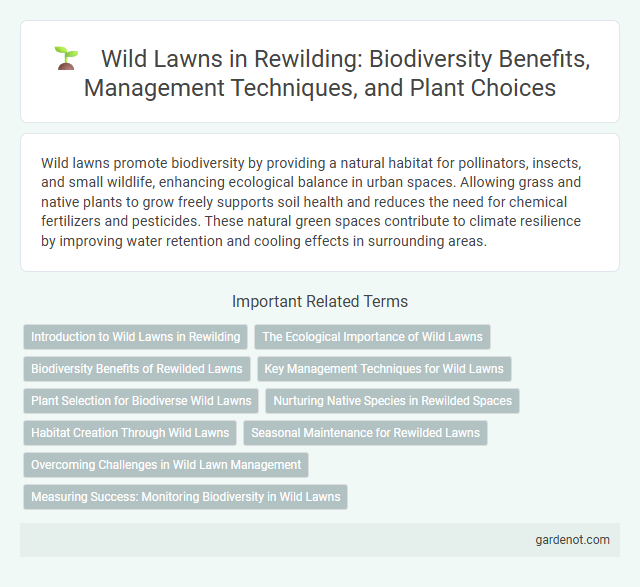Wild lawns promote biodiversity by providing a natural habitat for pollinators, insects, and small wildlife, enhancing ecological balance in urban spaces. Allowing grass and native plants to grow freely supports soil health and reduces the need for chemical fertilizers and pesticides. These natural green spaces contribute to climate resilience by improving water retention and cooling effects in surrounding areas.
Introduction to Wild Lawns in Rewilding
Wild lawns play a crucial role in rewilding by transforming traditional grass-dominated spaces into biodiverse habitats rich with native plants and pollinators. These lawns promote ecological balance, support soil health, and offer refuge for local wildlife such as bees, butterflies, and ground-nesting birds. Incorporating wild lawns reduces maintenance demands, minimizes chemical use, and enhances urban and rural ecosystem resilience against environmental changes.
The Ecological Importance of Wild Lawns
Wild lawns support biodiversity by providing essential habitats for pollinators, birds, and beneficial insects often absent in conventional manicured lawns. Their native plant species improve soil health, enhance carbon sequestration, and regulate local microclimates, contributing to ecosystem resilience. By reducing chemical inputs and water usage, wild lawns promote sustainable urban landscapes that align with rewilding principles.
Biodiversity Benefits of Rewilded Lawns
Rewilded lawns transform traditional grass areas into rich habitats supporting pollinators, birds, and native insects, significantly boosting urban biodiversity. Incorporating diverse wildflowers and native grasses enhances soil health and contributes to ecosystem resilience by promoting natural pest control. Such biodiversity benefits improve ecosystem services, offering cleaner air and increased carbon sequestration within residential and public green spaces.
Key Management Techniques for Wild Lawns
Key management techniques for wild lawns include selective mowing to promote native plant diversity and prevent invasive species overgrowth. Incorporating seasonal cutting schedules helps maintain habitat quality for pollinators and ground-nesting wildlife. Mulching with organic material supports soil health and moisture retention, essential for a thriving wild lawn ecosystem.
Plant Selection for Biodiverse Wild Lawns
Selecting native grasses such as buffalo grass and fine fescues supports diverse insect populations, while incorporating wildflowers like coneflowers and black-eyed Susans enhances habitat complexity and seasonal blooms. Choosing plants adapted to local soil and climate conditions improves lawn resilience and reduces maintenance needs. Prioritizing a mix of flowering species and grasses creates a balanced ecosystem that attracts pollinators and promotes soil health.
Nurturing Native Species in Rewilded Spaces
Wild lawns play a crucial role in nurturing native species by providing essential habitats that support local biodiversity. These areas foster the growth of indigenous plants, which in turn attract pollinators like bees and butterflies, maintaining ecological balance. Emphasizing native flora in rewilded spaces ensures resilience against invasive species and promotes long-term sustainability of native ecosystems.
Habitat Creation Through Wild Lawns
Wild lawns support biodiversity by providing habitat for pollinators, ground-nesting birds, and beneficial insects. Native grasses and wildflowers foster microhabitats that encourage soil health and natural pest control. Transforming traditional lawns into diverse wild lawns enhances ecosystem resilience and promotes urban rewilding.
Seasonal Maintenance for Rewilded Lawns
Seasonal maintenance for rewilded lawns involves strategic mowing schedules, targeted watering, and selective weed control to promote native biodiversity and ecosystem health. Adjusting mowing height and frequency according to seasonal growth patterns ensures wildflowers and grasses can thrive, supporting pollinators and soil microfauna. Incorporating mulch applications and monitoring invasive species during spring and fall optimizes habitat restoration and sustains the ecological balance of wild lawns.
Overcoming Challenges in Wild Lawn Management
Wild lawn management faces challenges such as invasive species control, soil degradation, and maintaining biodiversity balance. Implementing adaptive mowing schedules and native plant reseeding enhances ecosystem resilience and supports pollinator habitats. Utilizing organic soil amendments and targeted invasive species removal promotes long-term vitality in wild lawn areas.
Measuring Success: Monitoring Biodiversity in Wild Lawns
Monitoring biodiversity in wild lawns involves regular surveys of plant and insect species richness, which serve as key indicators of ecological health and habitat complexity. Utilizing tools such as pitfall traps and quadrat sampling enables accurate assessment of species abundance and diversity over time. Data-driven analysis guides adaptive management, ensuring that wild lawns support native flora and fauna effectively while enhancing urban biodiversity.
Wild lawn Infographic

 gardenot.com
gardenot.com